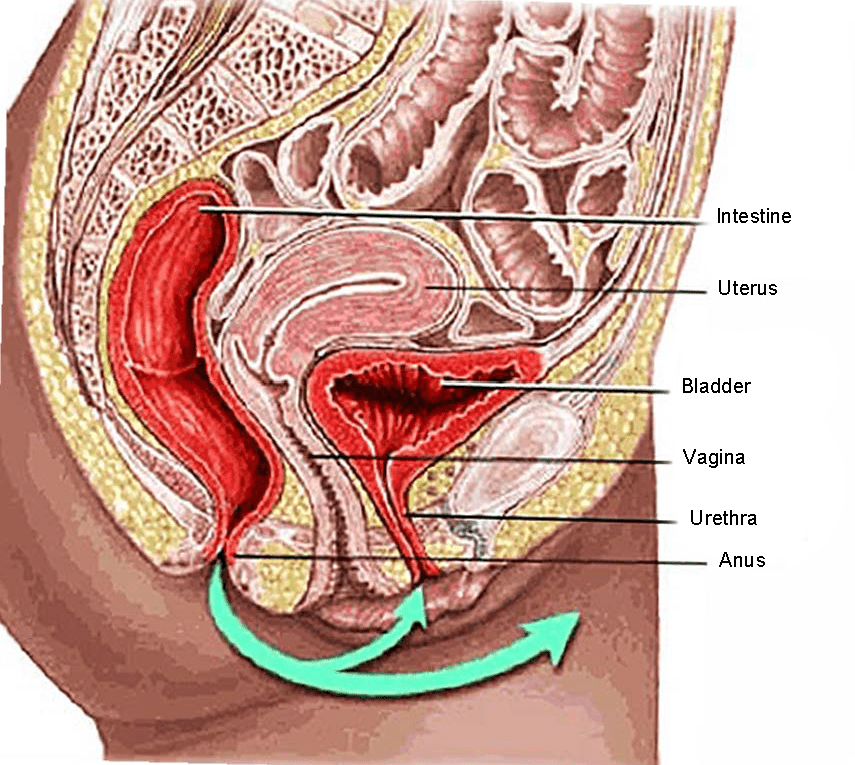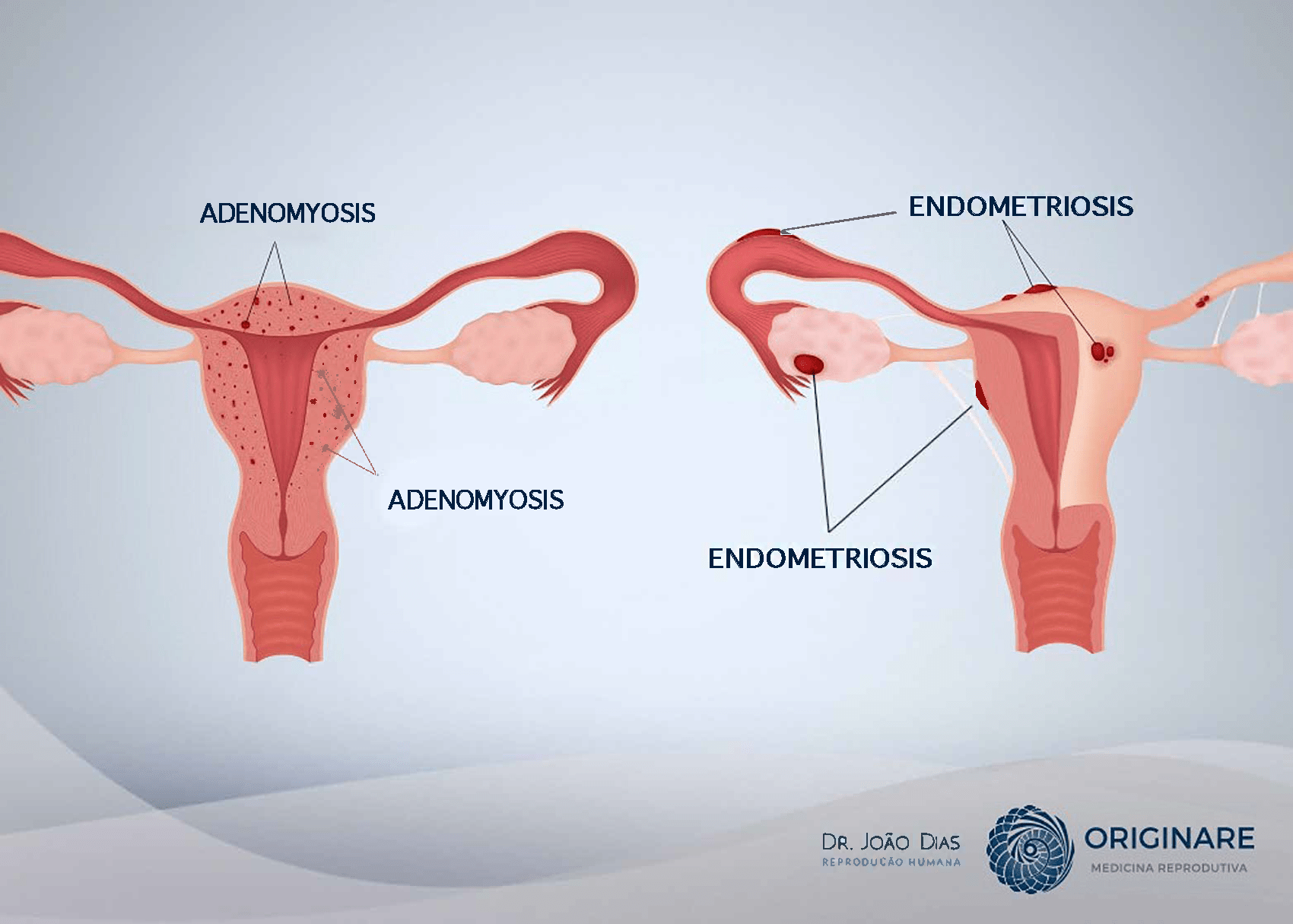Adenomyosis

What is adenomyosis?
Uterine adenomyosis is a benign disease where the thickening inside the uterus walls happens, provoking symptoms like pain, bleeding, or strong colic, especially during menstruation.
In adenomyosis, there is an endometrium infiltration that usually covers only the interior of the uterine cavity and starts to infiltrate itself on the uterus body wall thickness (myometrium).
That is called ectopic endometrial foci (outside the normal area) on uterus walls thickness.
What is adenomyosis?
Uterine adenomyosis is a benign disease where the thickening inside the uterus walls happens, provoking symptoms like pain, bleeding, or strong colic, especially during menstruation.

What is the uterus?
The uterus is an organ of the feminine reproductive system in the pelvic area, behind and above the bladder, ahead of the rectum, continuing down the vagina.
It is an organ with a central cavity, the uterine cavity, covered by the endometrium. The uterine wall is made mostly by a muscular layer called the myometrium.
The endometrium proliferates during the menstrual cycle and flakes off during menstruation, being externalized through the uterine cavity to the vagina and then to the exterior.
The endometrium and myometrium are separated by a layer called junctional line or transitional zone that defines the transition between the endometrium and the myometrium.
The uterus has different areas, being the uterus fundus the superior one, the cervix the inferior, and the body the biggest area, between the fundus and the cervix. The uterine cavity communicates with the interior of the uterine tubes (Fallopian tubes) at the level of the uterine fundus.

What is the uterus?
The uterus is an organ of the feminine reproductive system in the pelvic area, behind and above the bladder, ahead of the rectum, continuing down the vagina.
It is an organ with a central cavity, the uterine cavity, covered by the endometrium. The uterine wall is made mostly by a muscular layer called the myometrium.

The endometrium proliferates during the menstrual cycle and flakes off during menstruation, being externalized through the uterine cavity to the vagina and then to the exterior.
The endometrium and myometrium are separated by a layer called junctional line or transitional zone that defines the transition between the endometrium and the myometrium.
The uterus has different areas, being the uterus fundus the superior one, the cervix the inferior, and the body the biggest area, between the fundus and the cervix. The uterine cavity communicates with the interior of the uterine tubes (Fallopian tubes) at the level of the uterine fundus.
What are the adenomyosis symptoms?
The main adenomyosis symptoms are:
- Swollen abdomen;
- Stronger colic during menstruation;
- Pelvic pain, stronger during the premenstrual period;
- Painful intercourse;
- Increased quantity and duration of the menstrual flow;
- Constipation and painful defecation.
The first adenomyosis symptoms can come up 2 to 3 years after birth, even in cases where the woman already has adenomyosis since her childhood, and they usually stop arising after menopause, when the menstrual no longer happens.
What kind of adenomyosis are there?
Adenomyosis can be focal, nodular, or diffuse, according to the invasion level of the endometrium in the uterus body.


How can I diagnose adenomyosis?
An ultrasound scan is sufficient in most cases. However, pelvic MRI is the preferred exam because it diagnoses adenomyosis more precisely.
The MRI criteria to diagnose adenomyosis are over 12 mm junctional line thickness that separates the endometrium from the myometrium and microcysts on the uterine body thickness.

How can I diagnose adenomyosis?
An ultrasound scan is sufficient in most cases. However, pelvic MRI is the preferred exam because it diagnoses adenomyosis more precisely.
The MRI criteria to diagnose adenomyosis are over 12 mm junctional line thickness that separates the endometrium from the myometrium and microcysts on the uterine body thickness.
Can adenomyosis affect pregnancy?
Adenomyosis can provoke serious complications in pregnant women, such as ectopic pregnancy or miscarriage, for example. It is recommended regular follow-up by the obstetrician to avoid these complications.
Besides, in some cases, adenomyosis can complicate the fixation of the embryo on the uterus, making pregnancy harder, leading to infertility.
Adenomyosis symptoms usually appear after pregnancy, due to the uterus increase. That is why most women can get pregnant and have kids before having the disease.
What are the adenomyosis causes?
Adenomyosis causes are still not very clarified. However, this condition can be the result of uterus traumas due to gynecologic surgeries, more than one pregnancy, or due to cesarean delivery, for example.
Besides, adenomyosis can be one of the causes of other problems, such as dysmenorrhea or abnormal uterine bleeding, and often difficult to diagnose.
What are the treatment options?
Adenomyosis treatments include medication such as anti-inflammatory drugs to relieve pain and inflammation. Treatments with hormonal drugs like oral contraceptives with progesterone, Danazol, or intrauterine device with progesterone are also frequently used.
Surgery usually consists in removing the uterus or hysterectomy. The surgery to remove the uterus removes completely all the disease symptoms. However, it is only performed in more serious cases, when a woman no longer wants to get pregnant and when adenomyosis causes constant pain and abundant bleeding.
This disease can be cured with surgery to remove the uterus. However, this type of treatment is only made when symptoms can’t be controlled with anti-inflammatory drugs or hormones, for example.
There had been a lack of an effective treatment to adenomyosis that allowed the uterus preservation – in that context, Uterine Embolization started to be utilized. Uterine embolization is an effective option in the treatment of symptoms of women with adenomyosis and allows the uterus to be preserved.
What are the differences between adenomyosis and endometriosis?
Whilst in adenomyosis the ectopic endometrial foci are only on the uterus wall thickness, in endometriosis, ectopic endometrial foci are outside the uterus, usually on the walls of the pelvic area or on other pelvic organs.
Whereas adenomyosis can be treated with Uterine Embolization, endometriosis can’t. It is not rare for a patient to have both adenomyosis and endometriosis since the two diseases have very similar processes and common causes. They are manifestations of the same disease type in different areas.

What are the differences between adenomyosis and endometriosis?
Whilst in adenomyosis the ectopic endometrial foci are only on the uterus wall thickness, in endometriosis, ectopic endometrial foci are outside the uterus, usually on the walls of the pelvic area or on other pelvic organs.
Whereas adenomyosis can be treated with Uterine Embolization, endometriosis can’t. It is not rare for a patient to have both adenomyosis and endometriosis since the two diseases have very similar processes and common causes. They are manifestations of the same disease type in different areas.

Get in Touch.
Submit the form to schedule your appointment with Dr. Tiago.
Get in Touch.
Submit the form to schedule your appointment with Dr. Tiago.




